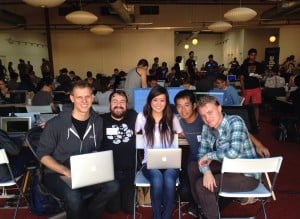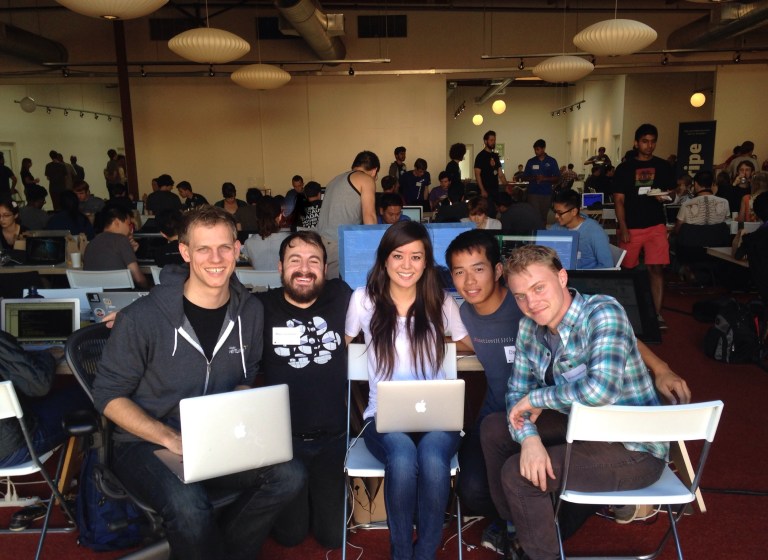
(Courtesy of Ernestine Fu)
HelloWorld, an app created by Stanford alumni, hit its download limit shortly after its release on Saturday evening. The first version of the app was created at the YCombinator hackathon, which took place in Mountain View this past weekend.
“From a technical standpoint, I’m really proud of our engineering team,” said team leader Ernestine Fu ’13.
Fu worked with fellow Stanford alumnus David Li ’10, as well as Jeff Himmelman, Max Goodman and Michael Carter, to create the app in around 30 hours.
Untraditional launch and response
Creating and launching a product like HelloWorld at a hackathon event is not a traditional model for success, but Fu explained that the launch method is part of a more optimized strategy to build the app.
“Hackathons have been about prototypes that prove a point, or a proof-of-concept,” Fu said.
“We’re trying to set that trend – this is the perfect opportunity to get a product done quickly, launch the same day, then iterate through it,” she added.
Fu said that they intentionally chose this particular event for launch due to the organized, well-known Silicon Valley institution YCombinator. The app also used TestFlight, a development platform associated with Apple’s Business-to-Business (B2B) iOS developer program.
Carter explained that the team used TestFlight to avoid the long product review times associated with the iOS App Store. He said that HelloWorld’s simultaneous releases for iOS and Android made it necessary to bypass the traditional review process for the iOS App Store, which takes on average around two weeks.
The product was a hit with users and reached the TestFlight developer program’s limit on downloads soon after its launch. According to the team, the app was getting on average one new user per minute, and the high signup rate peaked at 20 new users per minute.
Fu explained that the app filled with users so quickly that they currently have a few thousand people on the waitlist. To accommodate those on the waitlist, the team announced the opening of a “reserve username” option that lets you sign up and reserve your username with a phone number.
“We’ve launched a reserve username option for the few thousand people that couldn’t make it into our private beta,” Fu said.
Location-based social interactions
According to HelloWorld team member Li, the app’s core feature is allowing users to post status updates as well as see others’ updates.
“HelloWorld is basically fun and simple proximity status updates,” Li said.
Each “status” posted on HelloWorld includes text and a picture, which can be used as a background image for the status. The app also logs a general location of where the update was posted.
“Once you see if a friend is nearby and want to let them know that you are around, all you have to do is press one button,” Fu explained. “It sends them a push notification on their mobile devices.
Midway through the hackathon, the team made the decision to try dynamic location features. Whenever the user’s location changes, older or farther away activity moves lower down on the feed.
“Every time you open the app, the locations of all other posts are updated relative to your current location,” Fu said. “This was super fun because it allows you to interpret the world from your current context.”
Goodman detailed the location functionality with an example.
“HelloWorld leads to those delightful interruptions, like, ‘Oh wow, I haven’t seen [a friend] in weeks, and she’s 0.3 miles away! Is that at Old Pro?’” Goodman said. “And then I send her a ping so she knows I’m close, too.”
Combatting intrusive social media
HelloWorld’s differentiating factor, explained Fu, is the fact that it doesn’t show other users your exact location. Fu called the app a “backlash against Facebook status updates, Twitter updates and Foursquare check-ins.”
“We only share your proximity by default, but you can share your specific location with someone if you want to,” Fu said. “Facebook makes you check into a specific location, but we give users more control over what they say.”
According to Fu, the app is proximity-based rather than location-based, and status updates in the activity feed are ordered by a friend’s distance from the user. She explained that the app aims to provide a better online venue for sharing information.
“We find Facebook too creepy and Twitter to be the entirely wrong forum [for sharing],” Fu said.
Contact Nitish Kulkarni at nitishk2 ‘at’ stanford ‘dot’ edu.
